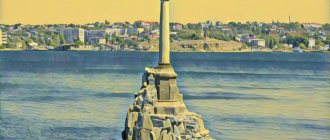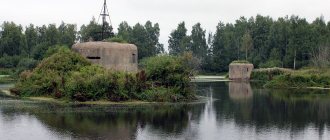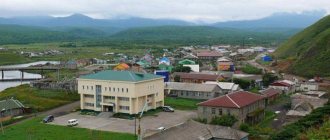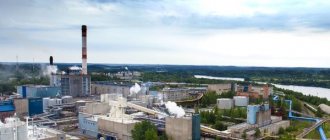| Top 10 best areas of the Leningrad region to live |
| Place | Name | Characteristics in the rating | |
| 1 | Vsevolozhsky | Large selection of new buildings, good environment, infrastructure and transport accessibility | |
| 2 | Vyborg | The area borders Finland, European architecture, good ecology | |
| 3 | Gatchinsky | Developed industry, the historical center of Gatchina is included in the UNESCO World Heritage List | |
| 4 | Priozersky | Agriculture is developed, there are many lakes, bays and rivers. Small population | |
| 5 | Kirishsky | Developed meat and dairy production, livestock farming, vegetable growing and wood processing industries | |
| 6 | Tosnensky | Good ecology. The area has places of historical significance | |
| 7 | Kirovsky | Good ecology, historical sights | |
| 8 | Lomonosovsky | On the territory there is a semi-enclave in the form of Sosnovy Bor. There are only towns and villages in the area | |
| 9 | Volosovsky | Country house construction predominates | |
| 10 | Volkhovsky | Developed wood processing, food industry and agriculture | |
| The best areas of the Leningrad region to live | |||
| Place | Name | Characteristics in the rating |
| 1 | Kingiseppsky | Recognized as contaminated as a result of the accident at the Chernobyl nuclear power plant |
| 2 | Luzhsky | Recognized as the poorest area |
| 3 | Tikhvinsky | The most distant from St. Petersburg |
Compiling a rating of the best districts of an entire region, and even simply choosing one of them, is not an easy task. Especially when it comes to such an important and significant subject of the Russian Federation as the Leningrad region. It has to be considered separately from St. Petersburg (it is not part of it, it is an independent entity)
, but even without it you can find a lot of interesting things in it - excellent nature and well-developed infrastructure, beautiful views and comfortable housing, rich history and big plans for the future.
By the way, only last year the elections of the best districts of the Leningrad region were carried out by its own authorities. They were judged on various factors, from the level of safety and quality of housing and communal services to the economy and land management. It’s funny that the Leningrad region authorities promised to give the winners additional funds for improvement as a prize. Although it would seem that the losers need them more...
However, other people's competitions are not our business, we have our own rating.
We looked at many indicators, thought about where it is most comfortable to live, selected the ten best districts of the Leningrad region and compared them with each other. This is what we got.
The best areas of the Leningrad region to live
1st place – Vsevolozhsk
If you carefully consider and seriously analyze everything, it will become clear that the choice of the first place on the list is obvious. The Vsevolozhsk district of the Leningrad region is not the largest in area and not the most densely populated, but it is adjacent to St. Petersburg, which is probably why so many people live in it. Namely – 399 thousand. The area of the area is enough to experience its diversity. There are large standard new buildings not far from the metro (more than a hundred residential complexes that have just been built or are under construction)
, and neat low-rise buildings in a country style
(you will be able to live with neighbors, and in complete privacy)
.
Both rich nature (forests, mainly pine, occupy 60% of the territory)
, and rich industry
(chemical, engineering, food...)
. The latter, of course, has its effect on the environment, but in the Vsevolozhsk region you will be able to find a place where you won’t even notice it. And thanks to all these plants and factories, it will be easier to find work. And for good infrastructure and transport accessibility, choose Vsevolozhsk, Yanino and Murino. The latter even has a metro, so you can get from the region to Nevsky Prospekt in 25 minutes.
2nd place – Vyborg
The main thing is not to confuse the Vyborg district of the Leningrad region with the Vyborg district of St. Petersburg. However, this is unlikely to be possible even if its area is 7.5 thousand square kilometers. Only the Podporozhsky district is larger, but the population there is much smaller, and it is many times further from St. Petersburg, while the Vyborg district borders it in the southeast. In the west, the Vyborg region borders on Finland. This is not only convenient (if you have a foreign passport, you can go to Europe for shopping at least every weekend)
, but also beautiful - both nature and architecture here are clearly subject to European influence. Well, if, of course, we assume that nature can be subject to anyone’s influence at all! Annual sailing regatta competitions and the Window to Europe film festival attract thousands of tourists here. If you want to travel to St. Petersburg more often, choose Roshchino; to Finland, choose Svetogorsk. If you don’t want to leave the Vyborg region, choose Vyborg – a city of unique beauty for Russia, founded in the Middle Ages. However, there are also plenty of new buildings in the Vyborg region. There will definitely be at least a couple of dozen, that is, there will be plenty to choose from.
3rd place – Gatchinsky
The abundance of industrial facilities, and simply the population in the Vsevolozhsk region can confuse those who consider the Leningrad region as a place for country living. Yes, it’s not quiet and peaceful everywhere, but you need to understand that there is nothing comparable in terms of infrastructure in the region. Let's take, for example, the Gatchina region. It also neighbors St. Petersburg and can also boast both developed industry and well-preserved nature. However, the number of new buildings here is ten times less, and the level and even appearance of all are approximately the same. When choosing where to live, pay attention to Gatchina itself - a city with almost a hundred thousand inhabitants, the largest settlement in the Leningrad region, the historical center of which, by the way, is included in the UNESCO World Heritage List. Other attractions include Pushkin’s nanny’s house, the Nabokov Museum and several more beautiful estates.
4th place – Priozersky
Last year, the authorities of the Leningrad region recognized the Priozersky district as the best among all its competitors. What did they find in him? It’s a long way from St. Petersburg, 145 kilometers, but on one side is Lake Ladoga, and on the other is the Republic of Karelia with its picturesque views. Here agriculture clearly prevails over more serious industry, which means that everything is in order with the environment. Apparently there are no complaints against the local department, since even the management is so pleased with them. There are few new buildings, and only a few that still have vacant apartments. But even there, even if you find an apartment building, prepare for seasonal rather than permanent residence. Even in the largest settlement in the region, the city of Priozersk, there are only 19 thousand people, a couple of medical institutions and about a dozen educational ones. However, for whom the Priozersky district is definitely suitable for living, it is fishermen and simply lovers of water views. Its name doesn’t lie – there are really a lot of lakes, bays and rivers nearby.
5th place – Kirishsky
The Kirishi district has existed in the Leningrad region since the early 1930s. Of course, it cannot be called particularly popular or even developing. The population is steadily falling, everyone is leaving villages for cities, and from cities - for larger cities, for example St. Petersburg. It’s not close to it (from Kirishi – 176 kilometers)
, but the train will take you to Ladozhsky Station in two hours. Also, if you want to have an interesting weekend, you can go to Veliky Novgorod - its region is also nearby. The production potential of the region, as Wikipedia calls it, is built on meat and dairy farming and vegetable growing; you can also go to work in the woodworking industry. And for recreation there are many children's camps and sanatoriums. In general, the infrastructure of the area is, of course, very provincial, there are almost no new buildings, but you can find a good apartment on the secondary market without any problems.
6th place – Tosnensky
The Tosnensky district in the north borders Kolpino, and from that it is not far from Pushkin and Pavlovsk. Therefore, many developers of the area ignore Tosno itself and give preference to the boundaries mentioned above. So, firstly, you get a good suburban environment, and, secondly, you have beautiful places of historical significance nearby. You can choose from about a dozen new buildings. To say that from the Tosnensky district you can quickly get to the center of St. Petersburg is probably still a lie, but in comparison with many other heroes of our rating, it clearly wins. From Tosno to Kolpino, for example, it is only 30 kilometers. This city itself, if you suddenly decide to settle in it, is a typical Russian province, famous mainly for its football club. If you are not a fan, you can at least count on a quiet life away from the metropolis.
7th place – Kirovsky
Another district whose name can be heard both in St. Petersburg and in the Leningrad region is Kirovsky. And if the urban area can be criticized for the fact that it seems frozen in the past and is almost not developing, then the regional one would like to be praised for the same thing. Take, for example, the small city of Shlisselburg, which is part of it, with the Oreshek fortress standing on the island, with the Neva beginning here. Or the city of Kirovsk, which dates back to Soviet history. In general, it’s surprising, but there are almost more new buildings in the Kirov district of the Leningrad region than in the district of the same name in the city. Apparently, the proximity to Kolpino and the Vsevolozhsk region and, accordingly, good transport accessibility have an effect. Public transport goes directly to metro stations - say, by bus to “Dybenko Street” it takes less than an hour. If, on the contrary, you don’t want to travel anywhere, then pay attention to the local production. “Pit-Product” sausages and “Sinyavinskie” eggs are from here, so they will always be fresh in stores. It’s somehow banal to praise the ecology of the area located on the shores of Lake Ladoga, but just in case, let’s note that it is very good here.
8th place – Lomonosovsky
Lomonosovsky district is a unique municipal entity for the Leningrad region, whose governing bodies are located in another subject of the Federation. Moreover, they are located in the city of Lomonosov, which, in turn, is not part of the Lomonosovsky district, but is part of the Petrodvortsovy district of St. Petersburg. And on its territory there is a semi-enclave in the form of Sosnovy Bor. The layout is confusing, but it shouldn't stop you from enjoying this place. If infrastructure, transport accessibility and the ability to choose from several new buildings are of paramount importance to you, then take a closer look at the eastern part of the area - the one that is closer to St. Petersburg. If good ecology and silence are more important to you (although in the east, objectively speaking, it’s not that loud!)
, forward to the northwest, to the shores of the Gulf of Finland. Whatever you choose, keep in mind that provincial life in the full sense of the phrase awaits you. There is not even a single city in the region, only towns and villages.
9th place – Volosovsky
In the south, the Lomonosovsky district borders the Volosovsky district, so in our list the second one turned out to be slightly lower than the first. From, in fact, the city of Volosovo to St. Petersburg is 43 kilometers, but Gatchina is very close. Have you noticed, by the way, that the lower we go in the rating, the more we begin to value good transport accessibility and the ability to get to St. Petersburg relatively quickly? Given that the population of the entire region is about 50 thousand people, it cannot be called particularly independent (well, what kind of infrastructure can you count on in a city with 10 thousand inhabitants?)
, much less acting only in conjunction with St. Petersburg
(Volosovo is still not so close to the city on the Neva as to be completely dependent on it)
. In light of all this, it is not surprising that local developers are attracting clients with dachas rather than apartments, temporary housing rather than permanent housing. All you need is to bring amenities to a decent level, borrow the appearance from European suburbs, and not raise prices - and then purchasing real estate in the Volosovsky district will be a really good decision.
10th place – Volkhovsky
Well, the finalist of our top ten is the Volkhov district of the Leningrad region, just like many others, located on the shore of Lake Ladoga. Area – just over five thousand square kilometers (sixth place in the region)
, population - 89 thousand people
(oddly enough, also sixth place)
, interestingness - there are no exact data, but the number is clearly small. The area cannot boast of being close to St. Petersburg, and therefore its infrastructure is no different. Industry and production on its territory are the same as in the region in general - woodworking, food, agriculture. The ecology is generally good, but, objectively speaking, few areas of the region can complain about it. Developers pay almost no attention to the Volkhov district. However, only a person who has never seen this lake can pass by and not at all appreciate the area, most of which faces Lake Ladoga.
General information about the Leningrad region
Distinctive features
. The Leningrad region is part of the Northwestern Federal District. Although instead of the city of Leningrad, St. Petersburg again strengthened in our minds, as in the good old days of the Russian Empire, officials did not change the name of the region. Most of the region's territory used to be part of the St. Petersburg province. The proximity of the capital left its mark on the economy and culture of these places. First of all, this is the abundance of architectural masterpieces that flood the surroundings of the northern capital. The palaces of emperors, empresses and representatives of the flower of the Russian nobility today have become museums attracting tourists to Lomonosov, Gatchina and other towns near St. Petersburg.
Gatchina is especially beautiful in summer
Geographical location
. When Tsar Peter I decided to found St. Petersburg, it seems that he did not care at all whether the local climate would be to the liking of the residents of the new capital of Russia. 60 degrees north latitude is no joke, and severe frosts are not uncommon here in winter, with temperatures easily reaching 25 degrees below zero. Despite the abundance of swamps, the nature here is very beautiful. There are 1,800 lakes in the Leningrad region, including Ladoga, the largest in Europe. The northern part of the region is washed by the waters of the Gulf of Finland, providing access to the Baltic Sea, and from there to the Atlantic.
Sukhodolskoye Lake
Population.
Despite its proximity to such a great city as St. Petersburg, the Leningrad Region is inferior in population to dozens of other regions of Russia. As of 2013, the population of the Leningrad region was 1.71 million people, which is explained by its northern location and harsh climate.
In terms of gender structure, there is practically no difference with the Moscow region (46.3% are men, 53.7% are women). In terms of population density, the region is in the very middle of the ranking (20.87 people per sq. km.) In terms of national composition, almost 93% of the region’s population are Russians. The largest age group is pensioners (22%), the smallest is children and teenagers (14.3%).
Crime
. In terms of crime level, the Leningrad region is in favorable 60th place in the ranking. The number of registered crimes per year is only 15 per 1000 people. Moreover, thanks to the excellent work of law enforcement agencies, there is a steady downward trend in the number of crimes.
Unemployment rate
in the Leningrad region is much higher than, for example, in Moscow or the Moscow region - 3.24%. But fortunately, this figure is decreasing every year. This is especially noticeable compared to 2000, when it was as much as 9.63%. However, in the ranking of regions by unemployment rate, the region firmly ranks 4th, which cannot please those who decide to live and work there. In terms of wages, the Leningrad region is second only to Moscow, St. Petersburg and the Moscow region. The average salary here fluctuates around 26,000 rubles.
Vsevolzhsk. Panorama. Photo by Rusbat-27
Property value
in the Leningrad region depends on the city, the quality of housing and the year of construction. The most expensive are new buildings in the suburbs of St. Petersburg. Due to their proximity to the center and good environmental situation, such objects are very attractive. Apartments in such new buildings can reach 10 million rubles for a three-room apartment. Inexpensive, budget housing costs from 1 million rubles.
Climate
Leningrad region - harsh, oh harsh. This is one of the main reasons why people do not want to move here. In summer it’s +17°C, in winter –10°C. The average annual precipitation is 600-700 mm. Summer and autumn are very rainy, so if you have a sunbathing day, try to make the most of it, otherwise you will have to wait until next year.
Worst areas
Residents of St. Petersburg can spend hours proving to you that, although Moscow is larger than their beloved city, and has a larger population, in general it is no better than it. What’s more, it’s worth looking at any modern artist to understand that popular popularity is not always an indicator of high quality. However, in the case of the districts of the Leningrad region, everything works exactly like this - the more popular the district, the better it is (however, the reverse logic is also true - the better the district, the more popular it is, but this is perhaps a banality)
.
A large population is not only of interest to developers, but also good infrastructure and attention from the authorities and other powers that be (for example, various large enterprises)
, which is especially important in the province.
The remaining districts of the Leningrad region can be blamed for their dubious ecology (for example, several settlements in the Kingisepp district were recognized as contaminated as a result of the accident at the Chernobyl nuclear power plant)
, for poverty
(according to research, a kind of “leader” in this indicator is Luzhsky)
, for the distance from St. Petersburg
(it’s about three hours by car from Tikhvin)
... But their common, and therefore the main problem is provincialism, the lack of any -or interest. While it is still possible to build dachas in these areas, no one is rushing here with large new buildings. This means that their chances for development are less and less. Green forests, clean waters, peace and quiet - this is great. But, alas, not when this is the only thing this or that place can offer us.
Georgy Paradny
Transport links, roads and routes
The Leningrad region has a well-developed network of roads and railways. The following highways of federal and republican significance pass through the region:
- M10 "Russia";
- P21 "Cola";
- R23 "Pskov".
Three border automobile checkpoints: “Trofyanovka”, “Scandinavia” and “Brusnichnoe”. There is a Narva checkpoint on the Estonian border. 4 cargo seaports were built on the Baltic coast of the region:
- Ust-Luga;
- Vyborg;
- Vysotsk;
- Primorsk
In addition to maritime shipping in the region, there is also river transport of goods and people along rivers and lakes. There is an international airport in Pulkovo.









